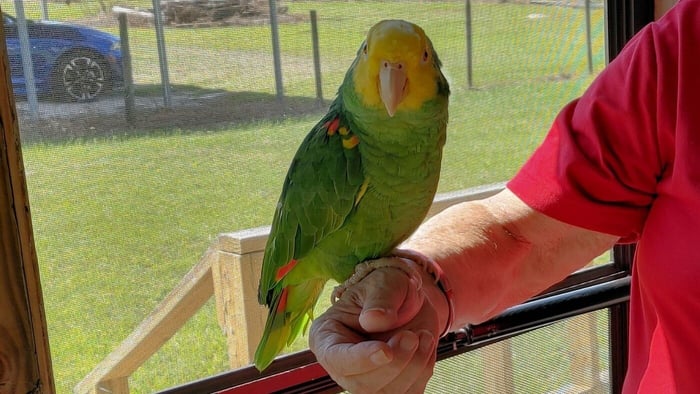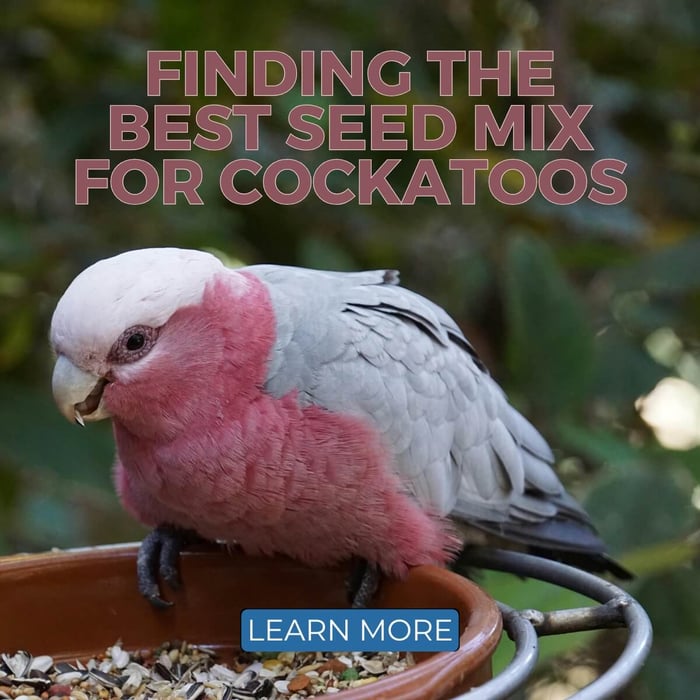Solving Common Parrot Behaviour Problems Fast
When you live with parrots, you quickly realise you are sharing your home with a highly intelligent, highly emotional little person in feathers. Screaming, biting, lunging at hands, refusing to step up, shredding the furniture: it can feel overwhelming. You might even find yourself wondering if you are doing something terribly wrong. You are not alone. Many owners quietly struggle with Parrot Behaviour Problems, and the good news is that most of them can be improved faster than you think once you understand why your bird is behaving that way, and what to do differently.
This guide walks you through calm, kind, practical steps you can start using today. No harsh methods, no force, just clear strategies rooted in how parrots actually think and feel.
It is not naughty, it is communication
The first mindset shift that changes everything: your parrot is not being spiteful or naughty. Every scream, nip, or lunge is a message.
- I am scared.
- I am bored.
- You have ignored me for hours.
- I do not understand what you want.
- This is my space, and I do not feel safe.
Once you view behaviour as information instead of a personal attack, it becomes much easier to respond calmly and effectively. You stop taking it to heart and start solving it at the source.
If a behaviour appears suddenly, becomes extreme, or comes with changes in droppings, posture, appetite or breathing, always speak to an avian vet first. Pain, illness, hormonal changes or discomfort can sit behind even the simplest behaviour change, and no amount of training will fix a bird who does not feel well. You can find help in our Avian Vets Directory.
Parrot Behaviour Problems: Understanding the ABC
Almost every behaviour pattern makes more sense when you look at three simple steps. Trainers call this the ABC.
- A: Antecedent: what happens before the behaviour
- B: Behaviour: what your bird actually does
- C: Consequence: what happens after the behaviour
For example:
- You walk out of the room, your bird screams, you rush back and talk to them. Your parrot has just learnt: when I scream, you come back. Perfect.
- You put your hand into the cage quickly, your bird lunges and bites, you pull your hand away. Your parrot has learnt: if I bite, the scary hand disappears. That works.
Parrots repeat behaviours that work for them. Once you change what happens after, you change what your bird learns.
1. Screaming: when noise becomes a habit
Every parrot will vocalise. They call to their flock, they react to sounds, and sometimes they simply enjoy being loud. But there is a difference between normal calling and relentless screaming that leaves you exhausted.
Why it happens
- Attention seeking: screaming reliably brings you running.
- Boredom: nothing to do, nowhere to focus that clever brain.
- Overstimulation: too much noise, light, or chaos.
- Anxiety: uncertainty in routine, lack of sleep, or feeling unsafe.
What you can do
Teach a good noise. Choose a sound you like, such as a whistle, a short phrase, or a soft chirp. Every time your parrot makes that noise, respond warmly. Talk back, offer a treat, or walk over for a quick hello. When the screaming starts, keep your response neutral: no eye contact, no words, no drama. Your bird gradually learns which sounds make good things happen.
Preempt the worst times. If evenings are the main problem, introduce a short play or training session just before that time. A new foraging toy, a simple training exercise, or a special chew toy from your enrichment box can redirect that energy into something positive.
Reward the quiet moments. Catch your bird being calm. Even a few quiet seconds are worth a soft good girl or good boy and a small treat dropped in the bowl. Over time, you are teaching that calm gets more attention than chaos.
2. Biting and lunging: protecting both fingers and trust
Few things shake your confidence like a determined parrot bite. It is painful, and it can feel very personal. But parrots usually bite because they feel cornered, confused, or forced, not because they are mean.
Why it happens
- Fear: hands come too fast or from above.
- Territoriality: guarding their cage, perch, favourite person or toy.
- Frustration: mixed messages, sometimes you accept a behaviour, sometimes you do not.
- Lack of choice: they feel they have no way to say no except with their beak.
What you can do
Stop setting up bites. If you already know a certain situation almost always leads to a bite, change it. Use a handheld perch instead of fingers. Open the cage door and invite your parrot out, rather than reaching in and cornering them. The less your bird practises biting, the less it becomes their default answer.
Use a target stick. A simple chopstick can transform your relationship. Teach your bird that touching the stick with their beak earns a reward. Once they understand this, you can gently guide them around the cage, onto a perch, or away from a hotspot, all without putting your hands in the line of fire.
Build a clear, positive step up. Start when your bird is relaxed. Offer your hand or a perch from below chest level, pause briefly, then reward and move away before they feel pushed. You are teaching: my hand comes, something nice happens, and you are not forced. Gradually wait longer, rewarding small attempts to step up.
3. Cage aggression: this is my space
Some parrots are delightful once they are out, but turn into tiny dragons when you go near the cage. It is easy to feel rejected, but from your bird's point of view, they are protecting the only territory they truly control.
Why it happens
- The cage is their safe space.
- Hands entering have often meant I am taking something away.
- They feel trapped if they cannot choose to move away.
What you can do
Change what hands mean. For a while, your hand should almost always arrive with something positive, such as a favourite treat, a new toy, or fresh food. Do as many add actions as possible and minimise take-away actions. This helps your parrot reassociate your presence with good things, not loss.
Work at the door, not deep inside. Invite your bird to come to the door. Offer a perch or your hand just outside the cage rather than reaching in after them. Step up at the threshold feels safer and gives them more choice.
Create a predictable routine. Let your parrot know roughly when you will clean, change bowls or rearrange toys. Predictability reduces anxiety, and less anxiety means less need to defend.
4. Fearful or rescue parrots: healing takes time
If you share your home with a rescue or a very nervous bird, you may see freezing, trembling, panting, frantic climbing, or panicked flight. These are not stubborn parrots, they are overwhelmed.
Kind steps you can take
Start at a safe distance. Find the spot where you can be present without triggering fear. That may be across the room at first, and that is fine. Consistency is more important than speed.
Pair yourself with good things. Several times a day, quietly walk past, place a treat in the bowl, speak softly, then leave. No pressure. No hands. Just: when I appear, something nice happens, and then I go.
Let your bird set the pace. As they relax, you can slowly move a little closer over days and weeks. Pushing too fast risks undoing progress. Slow, steady, respectful work builds trust that lasts.
Environment, enrichment and diet: quietly solving behaviour from the inside
You can often reduce parrot behaviour problems dramatically by supporting your bird's basic needs.
Foraging and toys. A bored parrot will invent their own entertainment, usually the sort you do not like. Rotate chewable and shreddable toys regularly, and offer foraging opportunities every day. Simple paper wrapped treats, food hidden in cardboard, or dedicated foraging toys from Parrot Essentials help channel that clever mind into something healthy.
Sleep and routine. Most parrots need around 10 to 12 hours of dark, quiet rest. Late nights, bright screens and constant traffic through the room can leave your bird overtired and irritable, making biting and screaming far more likely.
Balanced diet. A high-quality diet supports mood, energy and overall well-being. Moving away from all seed feeding towards a more balanced mix, including quality pellets or complete foods, vegetables and suitable treats, can improve your parrot's resilience and behaviour over time. As always, make changes gradually so your bird accepts them happily.
You do not have to fix everything overnight
Behaviour does not change in a single day, but you can start turning things around today.
Pick one issue that bothers you most. Observe the ABC: what happens before, what your bird does, and what you do after. Then choose one or two of the strategies above and commit to them for a week. Short, frequent, positive sessions are far more effective than one long, stressful attempt.
You will likely notice small shifts first: a shorter screaming spell, fewer lunges, more curiosity, and a little calmer. Those small wins are your proof that your effort is working, and that your parrot is trying too.
Ready to Tackle Parrot Behaviour Problems with Parrot Essentials?
Parrot behaviour problems are not a sign that you have failed as an owner. They are an invitation to understand your bird more deeply and build a stronger bond.
If you are ready to:
- Turn screaming into calmer communication
- Reduce biting and rebuild trust
- Keep your parrot busy with healthy, engaging activities
Your next step is simple. Explore the parrot toys, foraging solutions and complete diets at Parrot Essentials to support your training, and visit our blog for more expert guides on behaviour, nutrition and enrichment.
Your parrot is capable of incredible change, and with the right tools, patience and guidance, so are you.
FAQs
Why has my parrot suddenly started biting me?
Sudden biting can be a sign of fear, pain, hormonal changes, or frustration. Start by looking for any changes in your parrot's environment, routine, or how you are handling them. If the biting appears out of nowhere, is severe, or comes with other changes such as fluffed up feathers, altered droppings, or reduced appetite, speak to an avian vet to rule out medical issues. Once health is checked, focus on rebuilding trust with slow, predictable handling, target training, and always respecting your parrot's body language.
Is my parrot screaming for attention or just being noisy?
Most parrots naturally call at certain times of day, especially in the morning and evening. However, intense, prolonged screaming that stops the moment you enter the room is usually attention-seeking. If your bird has learned that screaming makes you come back, they will keep doing it. Offer structured attention at set times, provide plenty of toys and foraging, and calmly ignore excessive screaming while rewarding quieter, more acceptable sounds.
How long does it take to improve Parrot Behaviour Problems?
There is no fixed timeline because every bird and every household is different. Some behaviours improve within a few days when you change your responses and add enrichment. Others, especially long-standing habits or fear-based behaviours, may take weeks or months. Consistency matters more than speed. Short, daily training sessions and a steady routine usually work far better than occasional big efforts.
Should I punish my parrot for bad behaviour?
No. Punishment such as shouting, tapping the beak, squirting water, or shaking the perch can damage trust, increase fear, and often make behaviour worse. Parrots do not understand punishment in the way humans do. Instead, change the environment, remove rewards for unwanted behaviour, and actively reinforce the behaviours you want to see more of, such as calm body language, gentle beak use, and acceptable vocalisations.
My parrot is lovely with me but aggressive with other family members. Why?
It is very common for parrots to form a strong bond with one person and to feel unsure, jealous, or defensive around others. Non-favourite people may also move faster, speak louder, or offer hands in a way the bird finds intimidating. Ask other family members to become the givers of good things: special treats, favourite toys, and calm conversation from a comfortable distance. Avoid forcing contact and let your parrot choose when to come closer.




